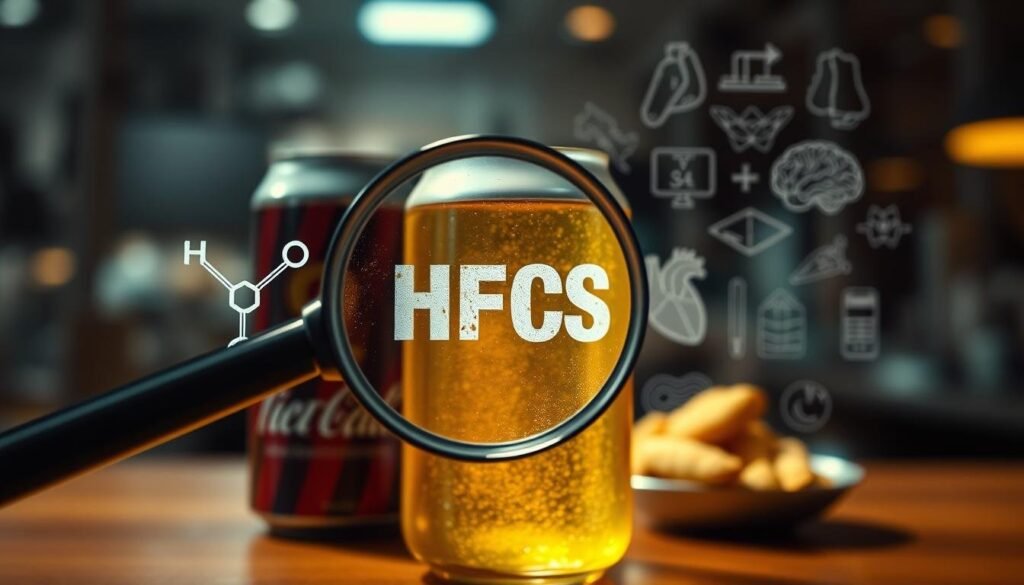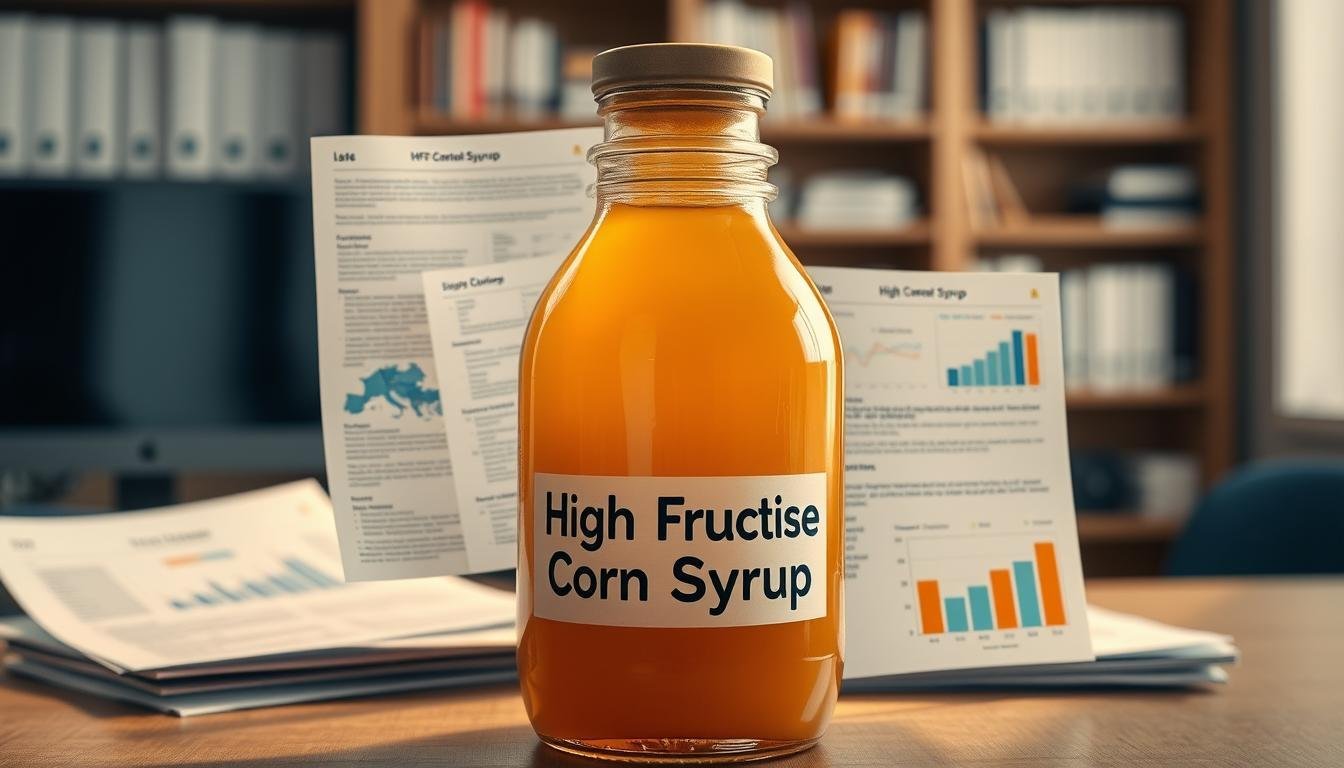Is High Fructose Corn Syrup Banned in Europe? You may have heard that high fructose corn syrup is banned in Europe. But what does this mean for you as a consumer?
The debate about this sweetener, made from cornstarch, has raised health concerns. This has led to different regulations around the world.
Knowing the truth about this claim and the regulations in Europe can guide your health choices.
Contents
- 1 What Is High Fructose Corn Syrup?
- 2 Is High Fructose Corn Syrup Banned in Europe?
- 3 European Regulations on Food Additives and Sweeteners
- 4 Why Europe Limits High Fructose Corn Syrup
- 5 HFCS in the United States vs. Europe
- 6 Health Implications of High Fructose Corn Syrup
- 7 Conclusion: Is High Fructose Corn Syrup Banned in Europe?
- 8 FAQ
- 8.1 What is high fructose corn syrup?
- 8.2 Is high fructose corn syrup banned in Europe?
- 8.3 Why does Europe limit high fructose corn syrup?
- 8.4 How does the regulation of high fructose corn syrup differ between the United States and Europe?
- 8.5 What are the health implications of consuming high fructose corn syrup?
- 8.6 How does the European Union regulate food additives like high fructose corn syrup?
- 8.7 What is the difference between high fructose corn syrup used in the US and Europe?
- 8.8 Are there any alternatives to high fructose corn syrup?
What Is High Fructose Corn Syrup?
High Fructose Corn Syrup (HFCS) is a sweetener made from cornstarch. It’s created through an enzymatic process. This process changes glucose into fructose, making a mix that’s 42% to 90% fructose.
It’s used in many foods like baked goods, drinks, and snacks. This is because it’s versatile and cheap.
Uses of High Fructose Corn Syrup in Food Products
HFCS is used in many products because it’s sweet and helps preserve food.
- Baked goods: HFCS keeps them moist, improving their texture and shelf life.
- Beverages: Many soft drinks and sweet drinks use HFCS as their main sweetener.
- Processed snacks: HFCS adds flavor and texture to snack foods.
| Product Category | Common Use of HFCS | Benefits |
|---|---|---|
| Baked Goods | Moisture retention, sweetness | Enhanced texture, longer shelf life |
| Beverages | Primary sweetener | Consistent sweetness, cost-effective |
| Processed Snacks | Flavor enhancement, texture modification | Improved taste, appealing texture |
Learning about HFCS helps you make better choices about what you eat. It’s good to know about it when you’re thinking about processed foods.
Is High Fructose Corn Syrup Banned in Europe?
Europe has strict rules for high fructose corn syrup, unlike the U.S. It’s not banned, but the European Union has clear guidelines for its use in food.
Rules on HFCS vary by country in Europe. This shows different views on this sweetener. Some countries limit its use more because of health worries.
The EU allows certain HFCS types in specific products, but with rules. Here’s a quick look at HFCS rules in some European countries:
| Country | HFCS Regulatory Status | Permitted Uses |
|---|---|---|
| Germany | Restricted | Baked goods, beverages |
| France | Regulated | Certain dairy products, processed foods |
| UK | Allowed with limits | Various processed foods, confectionery |
Knowing these rules helps you understand food additives in Europe better. As a consumer, knowing these differences helps you make better choices.
European Regulations on Food Additives and Sweeteners
The EU has strict rules on food additives, including sweeteners. These rules are based on science to keep your food safe.
The European Food Safety Authority (EFSA) checks food additives carefully. They use the latest science to make sure they’re safe for you.
Safety Assessments for Food Additives
Before adding a new food additive, it’s thoroughly checked. The EFSA looks at what it’s made of, how it’s used, and its health effects. They also keep updating their checks as new science comes in.
The EU is serious about keeping you healthy. They make sure all additives are safe before they’re allowed. So, you can be sure the food you buy is safe.
Some important parts of the EU’s rules include:
- Comprehensive safety assessments for all food additives
- Continuous monitoring of approved additives
- Strict labeling requirements to inform consumers
The EU’s strict rules mean they put your health first. They aim to keep you safe and healthy with their food safety standards.
Why Europe Limits High Fructose Corn Syrup
Europe’s stance on HFCS is surprising. It’s because of the health risks it poses. These risks include obesity, diabetes, and heart disease.
Europe’s cautious approach to HFCS is based on research. Studies show that HFCS can lead to health problems.
Health Concerns and Regulatory Actions
Europe’s rules on HFCS are part of a bigger plan. They want to lower diet-related health issues. By limiting HFCS, they aim to reduce these problems.
| Health Concern | European Regulatory Measure |
|---|---|
| Obesity | Limiting HFCS in food products |
| Diabetes | Promoting awareness of sugar content |
| Cardiovascular Disease | Encouraging the use of alternative sweeteners |
Europe’s focus on HFCS health risks is clear. By understanding these concerns and actions, you can make better diet choices.
HFCS in the United States vs. Europe
Did you know that the U.S. has looser rules for HFCS than Europe? This is because they have different ways of handling food rules.
In the United States, HFCS is found in many foods, like baked goods and soft drinks. The FDA says it’s safe to eat. So, it’s everywhere in American food.
But Europe is more careful. The European Food Safety Authority (EFSA) watches over food additives, including HFCS. While it’s not banned, its use is tightly controlled and must be clearly labeled.
| Regulatory Aspect | United States | Europe |
|---|---|---|
| Regulatory Body | FDA | EFSA |
| HFCS Status | Generally Recognized as Safe (GRAS) | Subject to stricter controls |
| Labeling Requirements | Not required to be labeled specifically | Required to be labeled |
These rules show two different views on food safety and protecting consumers. Knowing these differences is key when thinking about HFCS.
Europe’s stricter rules might make people choose other sweeteners. In contrast, the U.S. rules let HFCS be used widely.
Health Implications of High Fructose Corn Syrup
It’s important to know how HFCS affects our health. HFCS is a sweetener found in many foods. It has been studied a lot for its health effects.
Research has looked into how HFCS might be linked to obesity, diabetes, and heart disease. Some studies suggest a connection, but the evidence is still not clear.

Remember, HFCS is just one of many sweeteners in foods. Its health impact is similar to other sweeteners, natural or artificial. It’s best to eat in moderation.
To eat better, stay updated on HFCS and sweetener research. Read food labels and know what’s in your food. This helps you control your HFCS and sweetener intake.
As more research comes out, we see that a balanced diet is key. Eating whole foods and avoiding processed ones helps avoid health issues linked to HFCS and other sweeteners.
Conclusion: Is High Fructose Corn Syrup Banned in Europe?
You now know that high fructose corn syrup isn’t banned in Europe. But, the EU has stricter rules because of health worries. Knowing these rules helps you make better food choices.
Understanding food additives is complex. Europe and the U.S. have different ways of handling them. Europe’s strict rules on HFCS show their focus on food safety and health.
Knowing these differences helps you control your HFCS intake. It lets you choose foods that fit your health goals. Keeping up with food rules and additives like HFCS is key to a healthy diet.
See Also: Effexor Banned in Europe: What You Need to Know
FAQ
What is high fructose corn syrup?
High fructose corn syrup is a sweetener made from cornstarch. It’s made by changing glucose into fructose through an enzymatic process.
Is high fructose corn syrup banned in Europe?
High fructose corn syrup isn’t banned in Europe. But, the European Union has stricter rules on its use than the United States.
Why does Europe limit high fructose corn syrup?
Europe limits it because of health concerns. These include obesity, diabetes, and heart disease.
How does the regulation of high fructose corn syrup differ between the United States and Europe?
The US allows wide use of high fructose corn syrup. Europe, however, has stricter controls. This shows different views on food regulation.
What are the health implications of consuming high fructose corn syrup?
Studies suggest it might be linked to health problems. But, the evidence is still not clear. More research is needed.
How does the European Union regulate food additives like high fructose corn syrup?
The EU has a detailed system for food additives. They do thorough safety checks before approval. This ensures safety for consumers.
What is the difference between high fructose corn syrup used in the US and Europe?
The US often uses a version with about 55% fructose. Some European countries might use different concentrations.
Are there any alternatives to high fructose corn syrup?
Yes, there are alternatives. Natural sweeteners like honey, maple syrup, and agave nectar are options. So are other sugar substitutes.

Marcellus Stark is an investigative journalist from San Francisco, USA. He writes about global bans, rules, and unusual laws. He shares clear, interesting, and well-researched stories that help readers understand surprising facts worldwide.

